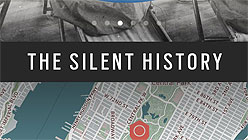“I didn’t notice anything wrong for a while,” says Emily Roark. “I just thought Becca was a silly, smart, weird kid. Good weird.” So begins a sister’s testimonial, one of 120 first-person narratives that form a portion of The Silent History, a comprehensive, interactive documentation of a fictionalized epidemic, delivered in daily segments to your iPad or iPhone.
The Silent History is part medical case study, part mystery novel, and part real-life scavenger hunt. It tells a gradually expanding story of children born without the ability to generate or comprehend language of any kind. Their condition stumps medical experts, torments parents, and sparks a media frenzy. Within the world of the novel they are commonly referred to as “silents.” The testimonials, beginning in 2011 and continuing 32 years into the future, come from parents, neighbors, teachers, classmates, health care professionals, reporters, and faith healers. Each voice offers a different opinion on the epidemic, retrospectively recounting their interactions with the perplexing case of the silent children.
Thus far into my description, The Silent History differs little from any serialized work of fiction. The innovative aspect of the project comes from incorporating the capabilities of smart devices into the story’s format. Creators Eli Horowitz and Russell Quinn are McSweeney’s alums with a vested interest in expanding digital publishing beyond uninspired e-books. The Silent History is both an experiment and a dramatic statement: what is possible when fiction and technology merge in a meaningful and innovative way?
In this vein, Silent History testimonials are balanced by “Field Reports,” site-specific narratives that can only be accessed from the physical location they describe. While testimonials are written by authors Kevin Moffet and Matthew Derby, field reports can be contributed by anyone engaged by the story and the wherewithal to submit their own take on the narrative.
As a recent convert to the world of smart phones and tablets, I am easily wowed by all the bells and whistles contained within my iPhone. The Silent History is not showy. Its various functions and basic navigation are smoothly designed and fairly intuitive. Most importantly, its existence within the device seems necessary and altogether natural.

 The story takes place in the near future, detailing a believable (and exhaustively researched) epidemic as related by individuals who are frustrated, confused, and intrigued by its presence in their lives. The narrators’ solitary conditions are reflected in the solitary reading experience. (Each chunk of text is perfectly matched to a short morning commute.) Slowly, organically, connections appear between the different characters. Similarly, readers can access field reports at the periphery of the main narrative and experience new connections to the city around them.
The story takes place in the near future, detailing a believable (and exhaustively researched) epidemic as related by individuals who are frustrated, confused, and intrigued by its presence in their lives. The narrators’ solitary conditions are reflected in the solitary reading experience. (Each chunk of text is perfectly matched to a short morning commute.) Slowly, organically, connections appear between the different characters. Similarly, readers can access field reports at the periphery of the main narrative and experience new connections to the city around them.
